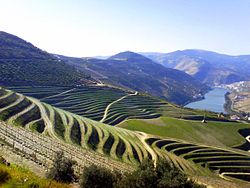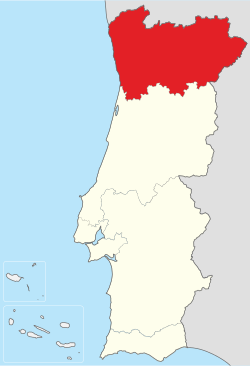
Back المنطقة الشمالية (البرتغال) Arabic Norte (Portugal) Breton Regió del Nord (Portugal) Catalan Norte (portugalský region) Czech Região Norte (Portugal) German Norda regiono (Portugalio) Esperanto Región del Norte (Portugal) Spanish Iparraldeko eskualdea (Portugal) Basque منطقه شمالی، پرتغال Persian Região Norte Finnish
North Region
Região do Norte | |
|---|---|
 The Douro Valley, where port wine is produced | |
| Etymology: norte, Portuguese for north | |
 Location of the North Region in Portugal | |
| Country | |
| Region | North |
| Capital | Porto |
| Area | |
• Total | 21,278 km2 (8,215 sq mi) |
| Population (2011) | |
• Total | 3,689,173 (1st) |
| GDP | |
| • Total | €78.660 billion (2023) |
| • Per capita | €21,509 (2023) |
| Time zone | UTC+0 (WET) |
| • Summer (DST) | UTC+1 (WEST) |
| HDI (2021) | 0.852[3] very high · 3rd |
| NUTS | PT11 |
| Statistics from INE (2005); geographic detail from Instituto Geográfico Português (2010) | |
The North Region (Portuguese: Região do Norte [ʁɨʒiˈɐ̃w du ˈnɔɾtɨ]) or Northern Portugal is the most populous region in Portugal, ahead of Lisbon, and the third most extensive by area. The region has 3,576,205 inhabitants according to the 2017 census, and its area is 21,278 kilometres (13,222 mi) with a density of 173 inhabitants per square kilometre. It is one of five regions of Mainland Portugal (NUTS II subdivisions). Its main population center is the urban area of Porto, with about one million inhabitants; it includes a larger political metropolitan region with 1.8 million, and an urban-metropolitan agglomeration with 2.99 million inhabitants, including Porto and neighboring cities, such as Braga, Guimarães and Póvoa de Varzim. The Commission of Regional Coordination of the North (CCDR-N) is the agency that coordinates environmental policies, land-use planning, cities and the overall development of this region, supporting local governments and associations.[4]
Northern Portugal is a culturally varied region. It is a land of dense vegetation and profound historic and cultural wealth. What is now Northern Portugal was first settled by various pre-Celtic and Celtic tribes before being visited by a number of Mediterranean civilizations who traded in its river-mouths, including Greek, Carthaginians, conquest by the Romans, invasion by Germanic peoples, and attacks by the Moors and the Vikings.
- ^ "Produto interno bruto (B.1*g) a preços correntes (Base 2021 - €) por Localização geográfica (NUTS - 2024); Anual". www.ine.pt. Retrieved 14 January 2025.
- ^ "Produto interno bruto (B.1*g) por habitante a preços correntes (Base 2021 - €) por Localização geográfica (NUTS - 2024); Anual". www.ine.pt. Retrieved 14 January 2025.
- ^ "Sub-national HDI - Subnational HDI - Global Data Lab". globaldatalab.org. Retrieved 31 July 2023.
- ^ "CCDR-N Uma instituição SMART" (PDF). CCDR-N. Archived from the original (PDF) on April 23, 2015. Retrieved September 13, 2017.